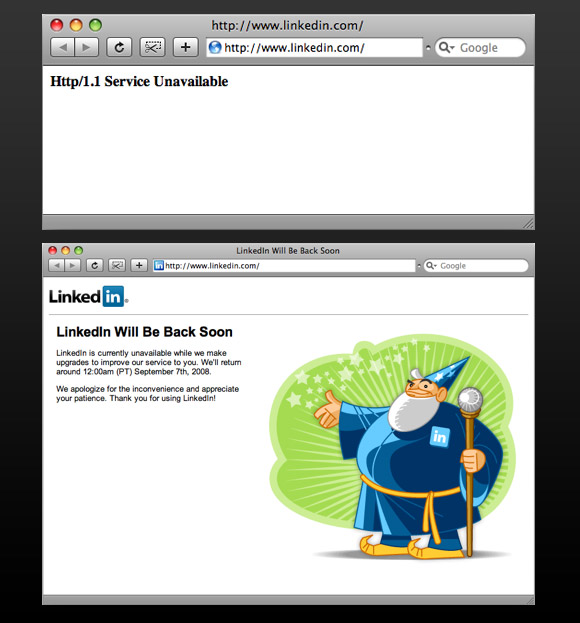LinkedIn, the popular social network for professionals, has had several periods of downtime lately. The last one came last evening (US time), and lasted just over an hour.
The website’s recurring availability issues are making us wonder if LinkedIn has perhaps started to run into scaling issues. According to their website, LinkedIn currently has more than 25 million users, compared to 14 million a year ago. That’s almost a doubling of their user base in just a year.
LinkedIn outages in September and October
Here are the latest outages, in reverse chronological order (detected by Pingdom’s own monitoring of www.linkedin.com):
- Oct 9: 1h 5m of continuous downtime in the evening, US time.
- Oct 2: 2h 30m of downtime spread over the day, including a one-hour outage and several shorter ones lasting 10-25 minutes each.
- Sep 23: A 30-minute outage in the evening, US time.
- Sep 6: 5h 25m of continuous downtime, starting in the evening, US time.
The longest outage for LinkedIn so far in 2008 occurred on September 6 (a Saturday), when the site was down for more than five hours, starting at 09:31 p.m. Eastern Daylight Time.
According to LinkedIn, this specific outage was due to maintenance work on their front end load balancer. LinkedIn did put up a maintenance message some time into the outage. (See screenshots further down.)
So far in 2008, LinkedIn.com has been unavailable for a total of more than 33 hours.
The nature of the problem
LinkedIn’s downtime doesn’t seem to be network-related. Every time the LinkedIn website has been unavailable, the error we have recorded is an HTTP 500 server error. It’s an unspecified “internal server error” reply from the web server which basically means that it’s unable to serve the requested page.
Australian blogger Mark Aufflick was able to take some screenshots of the LinkedIn website during the September 6 outage, which he has kindly let us include here below. You will also see a message from LinkedIn in the comments to his post, explaining the cause of the outage.

Screenshots courtesy of Mark Aufflick.
Is LinkedIn a victim of its own growth?
Aside from the already stated user base increase, third-party data from Google Trends for Websites shows that the number of daily visitors to the LinkedIn website is increasing steadily. Even if the absolute numbers reported by Google are estimates and won’t be 100% accurate, the trend is what counts here.
This is just speculation, but has LinkedIn started to run into scaling issues? It happens to most growing social networks at one point or another. Perhaps it’s LinkedIn’s turn now?
All monitoring performed by the Pingdom uptime monitoring service.


























